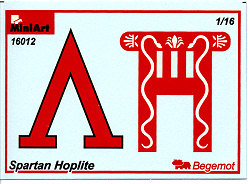
| KIT: | MiniArt 1/16 Spartan Hoplite |
| KIT #: | 16012 |
| PRICE: | $ |
| DECALS: | Two options |
| REVIEWER: | Scott Van Aken |
| NOTES: |

| HISTORY |
The hoplite was a heavy infantryman that was the central focus of warfare in Ancient Greece. The word hoplite (Greekὁπλίτης, hoplitēs) derives from hoplon (ὅπλον, plural hopla, ὅπλα) meaning an item of armour or equipment and consequently the entire equipment of the hoplite (but not specifically the circular shield, which is sometimes incorrectly referred to as a hoplon, though it was in fact called an aspis). These soldiers probably first appeared in the late seventh century BC. They were a citizen-militia, and so were armed as spearmen, and assumed a phalanx formation, which are relatively easy to equip and maintain; they were primarily drawn from the middle class, who could afford the cost of the armaments. Almost all the famous men of ancient Greece, even philosophers and playwrights fought as hoplites at some point in their lives.
Since the hoplites were a militia force and did not receive permanent wages, campaigns were short and mainly confined to the summer. Armies marched directly to their target. There, the defenders could hide behind city walls, in which case the attackers generally had to content themselves with ravaging the countryside (as siegecraft were undeveloped), or meet them on the field. Battles were usually set piece and intended to be decisive. These battles were short, bloody, and brutal, and thus required a high degree of discipline. Both forces lined up on a level field, usually in a rough rectangular formation around eight ranks deep (though this varied). Other troops were less important;hippeis (cavalry) generally protected the flanks, when present at all, and both light infantry and missile troops were negligible. The most well-known hoplites were the Spartans, who were trained from childhood in combat and warfare to become an exceptionally disciplined and superior fighting force.
| THE KIT |

 The single large and two smaller grey sprues are superbly molded with nary more than perhaps a bit of excessive seam flash here and there. It is obvious that the main sprue is used for at least one other figure (probably the Athenian) as some bits are not used in the making of this kit.
The single large and two smaller grey sprues are superbly molded with nary more than perhaps a bit of excessive seam flash here and there. It is obvious that the main sprue is used for at least one other figure (probably the Athenian) as some bits are not used in the making of this kit.
There is a nicely done display stand (not shown) provided and a single decal sheet that provides markings to place on the shield. In all it appears to be a pretty basic kit and its large scale makes it one that is ideal for those who would rather have something a bit on the larger size to work with. No construction instructions are provided, but there is a full color painting guide that indicates exactly where all the various bits are to be place. Color information is provided in Model Master, Tamiya, Humbrol, and Revell paint numbers.
| CONCLUSIONS |
While perhaps not everyone's cup of tea, it is a superbly done figure and one that I feel will build into an equally nice model when done.
| REFERENCES |
August 2007
My thanks to www.dragonmodelsusa.com for the preview kit. You can find this either at their website or at your favorite hobby shop.
If you would like your product reviewed fairly and quickly by asite that has nearly400,000 visitors a month, please contactme or see other details in the